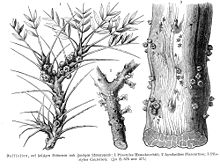
Back Аподантови Bulgarian Apodanthaceae BS Apodantàcies Catalan Apodanthaceae CEB Apodanthaceae Czech Apodanthaceae German Apodantacoj Esperanto Apodanthaceae Spanish خونفامیان Persian Apodanthaceae Finnish
| Apodanthaceae | |
|---|---|

| |
| Scientific classification | |
| Kingdom: | Plantae |
| Clade: | Tracheophytes |
| Clade: | Angiosperms |
| Clade: | Eudicots |
| Clade: | Rosids |
| Order: | Cucurbitales |
| Family: | Apodanthaceae Tiegh. ex Takht. |
| Genera | |
The family Apodanthaceae comprises about 10 species[1] of endoparasitic herbs. They live in the branches or stems of their hosts (as filaments similar to a fungal mycelium), emerging only to flower and fruit. The plants produce no green parts and do not carry out any photosynthesis (that is, they are holoparasitic). There are two genera: Pilostyles and Apodanthes.[2] A third genus, Berlinianche, was never validly published.[3]
The native range of Apodanthes is restricted to Central and tropical South America,[4] while Pilostyles has a much wider though disjointed native range, encompassing many countries in tropical and subtropical America, a section of Africa from Gabon to Tanzania and down to Zimbabwe, as well as Turkey, Iran, Iraq, and Western Australia.[5]
- ^ Christenhusz, M. J. M. & Byng, J. W. (2016). "The number of known plants species in the world and its annual increase". Phytotaxa. 261 (3). Magnolia Press: 201–217. doi:10.11646/phytotaxa.261.3.1.
- ^ Albert Blarer, Daniel L. Nickrent, and Peter K. Endress. 2004. "Comparative floral structure and systematics in Apodanthaceae (Rafflesiales)". Plant Systematics and Evolution 245(1-2):119-142.
- ^ Bellot, S., and S. S. Renner. 2013. "Pollination and mating systems of Apodanthaceae and the distribution of reproductive traits in parasitic angiosperms". "American Journal of Botany" 100(6): 1083–1094.
- ^ "Apodanthes Poit. | Plants of the World Online | Kew Science". Plants of the World Online. Retrieved 2024-02-28.
- ^ "Pilostyles Guill. | Plants of the World Online | Kew Science". Plants of the World Online. Retrieved 2024-02-28.